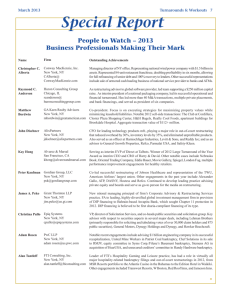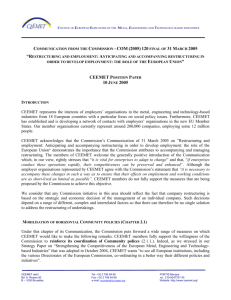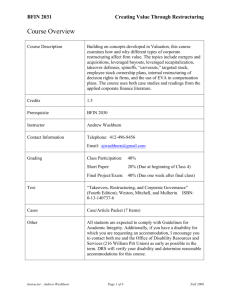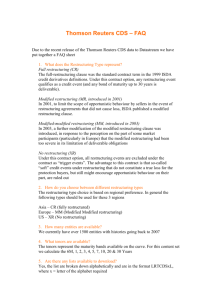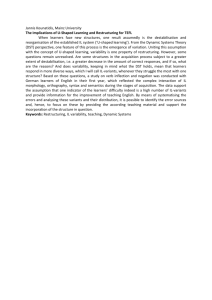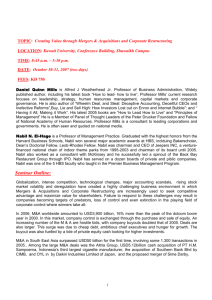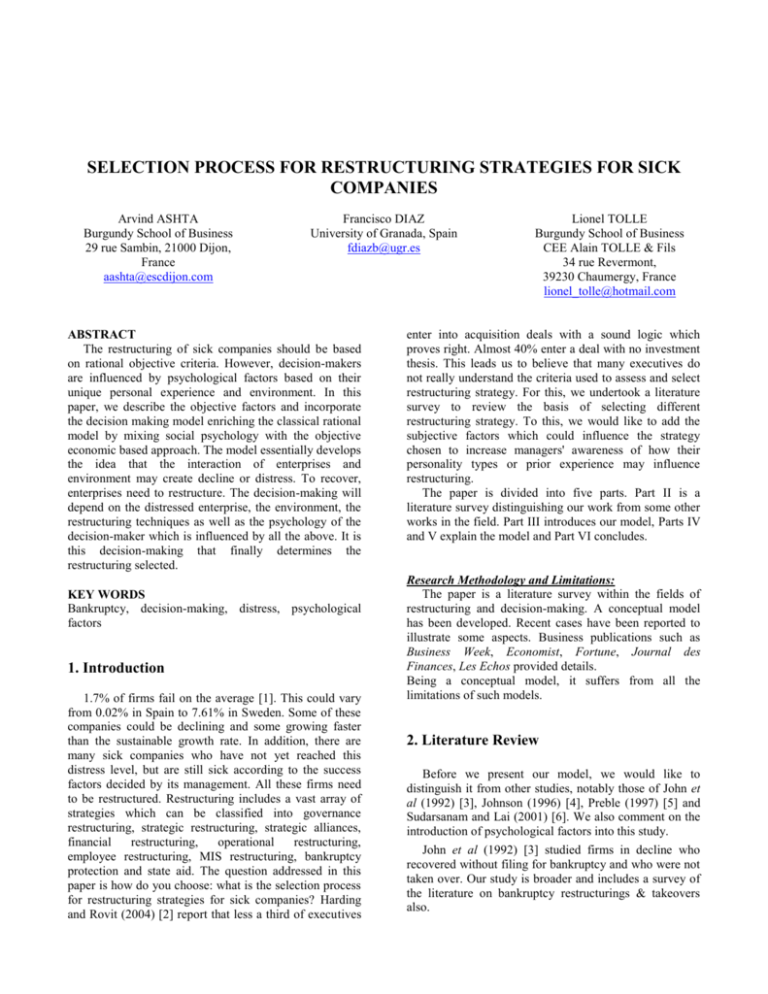
SELECTION PROCESS FOR RESTRUCTURING STRATEGIES FOR SICK
COMPANIES
Arvind ASHTA
Burgundy School of Business
29 rue Sambin, 21000 Dijon,
France
aashta@escdijon.com
Francisco DIAZ
University of Granada, Spain
fdiazb@ugr.es
ABSTRACT
The restructuring of sick companies should be based
on rational objective criteria. However, decision-makers
are influenced by psychological factors based on their
unique personal experience and environment. In this
paper, we describe the objective factors and incorporate
the decision making model enriching the classical rational
model by mixing social psychology with the objective
economic based approach. The model essentially develops
the idea that the interaction of enterprises and
environment may create decline or distress. To recover,
enterprises need to restructure. The decision-making will
depend on the distressed enterprise, the environment, the
restructuring techniques as well as the psychology of the
decision-maker which is influenced by all the above. It is
this decision-making that finally determines the
restructuring selected.
KEY WORDS
Bankruptcy, decision-making, distress, psychological
factors
1. Introduction
1.7% of firms fail on the average [1]. This could vary
from 0.02% in Spain to 7.61% in Sweden. Some of these
companies could be declining and some growing faster
than the sustainable growth rate. In addition, there are
many sick companies who have not yet reached this
distress level, but are still sick according to the success
factors decided by its management. All these firms need
to be restructured. Restructuring includes a vast array of
strategies which can be classified into governance
restructuring, strategic restructuring, strategic alliances,
financial
restructuring,
operational
restructuring,
employee restructuring, MIS restructuring, bankruptcy
protection and state aid. The question addressed in this
paper is how do you choose: what is the selection process
for restructuring strategies for sick companies? Harding
and Rovit (2004) [2] report that less a third of executives
Lionel TOLLE
Burgundy School of Business
CEE Alain TOLLE & Fils
34 rue Revermont,
39230 Chaumergy, France
lionel_tolle@hotmail.com
enter into acquisition deals with a sound logic which
proves right. Almost 40% enter a deal with no investment
thesis. This leads us to believe that many executives do
not really understand the criteria used to assess and select
restructuring strategy. For this, we undertook a literature
survey to review the basis of selecting different
restructuring strategy. To this, we would like to add the
subjective factors which could influence the strategy
chosen to increase managers' awareness of how their
personality types or prior experience may influence
restructuring.
The paper is divided into five parts. Part II is a
literature survey distinguishing our work from some other
works in the field. Part III introduces our model, Parts IV
and V explain the model and Part VI concludes.
Research Methodology and Limitations:
The paper is a literature survey within the fields of
restructuring and decision-making. A conceptual model
has been developed. Recent cases have been reported to
illustrate some aspects. Business publications such as
Business Week, Economist, Fortune, Journal des
Finances, Les Echos provided details.
Being a conceptual model, it suffers from all the
limitations of such models.
2. Literature Review
Before we present our model, we would like to
distinguish it from other studies, notably those of John et
al (1992) [3], Johnson (1996) [4], Preble (1997) [5] and
Sudarsanam and Lai (2001) [6]. We also comment on the
introduction of psychological factors into this study.
John et al (1992) [3] studied firms in decline who
recovered without filing for bankruptcy and who were not
taken over. Our study is broader and includes a survey of
the literature on bankruptcy restructurings & takeovers
also.
Johnson (1996) [4] establishes a link between certain
antecedents
(environment,
governance,
strategy,
performance and financial restructuring) and refocusing
strategies and between refocusing strategies and certain
outcomes. However, Johnson's model of downscoping
applies to healthy and distressed enterprises alike. We
would like to establish a more general model for
determining all kinds of restructuring but applicable to
sick enterprises.
Preble's (1997) [5] model deals with Crisis
Management. However, he details a model which takes
into account only crisis prevention. We are not linking our
notion of distress solely due to crisis of the environmental
disaster kind.
Sudarsanam and Lai (2001) [6] found that recovery
and non-recovery firms (those liquidated) have similar
strategies. However, unlike us, they do not distinguish
between restructuring strategies available for sick and
healthy companies.
All the above studies took into account only objective
criteria. However, we believe that we should consider and
include subjective and irrational factors in line with the
development of subjectivity and irrationality in economic
science [7]. In fact, in the last decades, some authors have
introduced psychological components in the study of
economic processes ([8], [9], [10], [11]) building a bridge
between Economy and Psychology and developing the
“Eonomic Psychology” area. This new focus tries to
incorporate a new component to the rational “homo
economicus”, introducing social and cognitive variables
according with individual and cultural differences.
If we apply this approach to the decisions in restructuring
processes, we could progress to a comprehensive model.
In keeping with this point of view, an important question
would be to determine if the decision is carried out in an
objective and rational way, evaluating the costs associated
to each decision or if it is modulated by personal irrational
variables.
3. A proposed model for Selecting
Restructuring Strategies for Sick Enterprises
In this section, we present a model of objective criteria
for restructuring. We consider that some characteristics of
the "Enterprise", its "Environment" and "Restructuring
Methods" affect any decisions of restructuring any kind of
firm. "Enterprise" and "Environment" also take part in
influencing the "Decline / Distress" (level or sources) that
will determine characteristics of “Sick Firm”.
We admit that distress is a characteristic of a firm, just
like growth. However, we maintain that distress assumes
an importance to firms that merits it being studied
separately from all the other characteristics of the
company. Just as individuals do not take optimum
decisions when exposed to losses [12]1), firms also have
restricted decision-making capacities during distress.
Therefore, we have included in our model a nonobjective box for the social and psychological factors
which influence the decision maker. We should keep in
mind the influence of these factors on the person taking
the decision. Decision is the result of a previous
communication process, which has been influenced by
different
psychological
and
individual
factors
(perceptions, knowledge, abilities and previous
experiences) and social factor [13]) such as group
influence. Studies have shown that decisions in group are
more risky (not necessarily worse) than those taken by an
individual [14]).
All these notions then interact in the process of
determining the appropriate "Restructuring Selected" for
declining or distressed enterprises. Graphically, the model
is illustrated in the figure.
Environment
Enterprise
Restructuring
Decline /
Distress
Sick Firm
DecisionMaking
Restructuring
Selected
We detail this model in the next two parts. In part IV,
we explain the objective factors influencing the choice of
restructuring and in part V, we introduce the different
subjective influences on the decision-making.
4.
Objective
Criteria
restructuring strategies
for
selecting
As noted from the model, the objective factors which
influence the selection of restructuring are the enterprise
or firm-specific factors, the environment, the
characteristics of restructuring strategies and the decline
or distress. We will summarize our findings from our
literature review and we will present some recent cases
studies in order to illustrate our findings.
The firm-specific factors which influence the
restructuring are based on managerial commitment [15],
1
Hilton cites a study by Shapira, 1999.
unit integration (establishment, company and group level)
([16], [17]), capital structure [18], technology [19], size
([6], [20], [21], [22]) and age ([23], [24], [25]). An
example of how a group structure can influence recovery
is given by Vivendi Universal. By ceding 20% of its
equity participation in its subsidiary Veolia
Environnement to 20.5%, it was able to deconsolidate the
group debt by 16 billion Euros, by changing the perimeter
of what is considered to be within the group. An example
of size influencing the availability of State Aid is
provided by Bull who has a long history of bailouts by the
French State. The last government loan of 450 million
Euros given in November 2002 will probably be repaid by
a fresh Government loan of 500 million Euros.
Some examples of the influence of environmental
factors on restructuring reported in the literature are based
on legislative (notably fiscal [21], antitrust [26] and
bankruptcy policies ([27], [28]), state aid [29]) and
economic environment (such as technology, economic
conditions and international competition which could lead
to downturns and consequential need to specialize to
remain competitive) ([30], [31]). As an example, a fiscal
policy which allows consolidated netting of group profits
and losses attracts holding companies into a country.
Vivendi Universal (VU) which has carry forward losses
of 30 billion Euros from 2001 and 2002 is negotiating
with the Finance Ministry to allow it to offset these
against the profits of SFR-Cegetel in which VU has a
55.8% share. A reduction in the tax-load by 8.3 billion
Euros would allow it to reimburse group debt or go in for
alternative acquisitions. Similarly, antitrust legislation
influencing restructuring is witnessed in the merger of
Promodès and Carrefour, the companies had to
accompany the merger by divesting agencies in certain
zones of dominance. This constraint becomes more
complex in an international setting. An instance of such
complications introduced by anti-trust policy would be the
EU’s refusal of the merger between two American
companies (Honeywell-GE, Worldcom-Sprint). As an
instance of economic conditions, the Thorn-EMI break-up
can be seen as a case of financial markets dictating the
need to refocus on core business [30].
The enterprise interacts with the environment and the
resultant may be a decline or a distress. Decline or
Distress includes the fact of decline/distress, the severity
of the problem and the cause of the problem. All of them
influence the kind of restructuring ([30], [37]).
Some restructuring options are clearly available for all
kinds of enterprises while others are clearly not available
for profitable organizations. For example, bankruptcy
proceedings are not available for healthy organizations.
Bankruptcy protection permits firms in some countries to
raise new debts because these get special protection [29].
This may explain why Parmalat has been able to raise
105.8 million Euros in new loans from a consortium of 20
banks, in spite of existing debts of 14.3 billions. The
recent failure of business firms indicate that governance
restructuring through a change in top management is more
likely for distressed companies. Pillmore (2003) [32]
explains that Tyco needed a very strong change in its
governance in order to underscore that previous mistakes
of managers will not be repeated. Tyco replaced Dennis
Kozlowski. Similarly, France Telecom replaced Michel
Bon, Vivendi Universal replaced Jean-Marie Messier,
Alstom replaced Pierre Bilger and Worldcom replaced
Bernie Ebbers.
The stage of decline or distress could influence
restructuring options. We could classify these stages as
(1) early decline, (2) initial distress, (3) acute distress,
(4a) liquidation or (4b) early recovery, and (5) drive to
normalization. At the moment, we could consider that
Ahold is in the initial distress, Alstom between the initial
& acute distress, Enron & Arthur Anderson are going for
liquidation, Worldcom is in early recovery after having
passed through bankruptcy. France Telecom & Vivendi
Universal have come from initial distress to the drive to
normalization without going through “acute distress”.
Different researchers testify to different restructuring
options used at different stages ([3], [6], [18], [19], [20],
[22], [35], [37]). For example, Brealey & Myers (2000)
[22] indicate that firms in distress would find it difficult to
sell off growth opportunities. Distress reduces the
negotiating ability of the enterprise. As a result, any sale
of assets is negotiated from a position of weakness. Sale
of loss-making ventures would be difficult. Sales of
profit-making ventures would also be at a much lower
price [35]). This is because often there are only a few
buyers for specific businesses and they are aware of the
seller's economic desperation. This is illustrated by the
case of Ahold who is desperately trying to divest its Disco
chain in Argentina to Casino or Francisco de Narvaez.
The restructuring must address the cause of the decline
or distress. Emery et al (2004) [24] list poor governance,
unwise expansion, intense competition, too much debt,
massive litigation as a few of the possible causes. In
general, we could say that causes may be linked to the
internal management (governance [38], unwise
expansions ([37], [39], [40]) of the firm or due to changes
in the environment (new threats, vanishing opportunities)
or to a combination of these. An example of an internal
management problem would be that the executive
directors' interests may not synchronize with the
company's interests [6]. For example, Ahold maintains
that its problems stem from erroneous expansion
decisions and inadequate controls over a handful of
individuals. To rectify the situation, 39 managers have left
the company and disciplinary action has been taken
against another 60 and the company is divesting some
activities. We have noted in several recent cases that
managers would even perpetuate corporate fraud to
enhance their interests. The case is well illustrated by
Enron executives using non-consolidated subsidies to offload debt from its balance sheet and the executives selling
their shares before the company sank2. Worldcom hid
operating expenses in capital expenditure. Ahold took into
account receipt of supplier incentives which it had not
even earned. The problem is essentially rooted in poor
governance and the solution is in governance restructuring
[41]. In many cases, the solution has been class-action
legal cases or criminal actions instituted against these
managers (example Skilling for Enron, Kozlowski for
Tyco, Messier for Vivendi, Tanzi for Parmalat). Many
recent cases would fit in as examples of unwise expansion
including Worldcom, Vivendi, France Telecom and
Ahold who all over-bought and did not take time to
consolidate. Restructuring required selling off part of the
acquisitions and refocusing. Enron would be a typical
case of an enterprise that suffered a decline in its
traditional business of electricity transmission and tried to
go into adjacent businesses and tried to hide the lack of
success behind financial and accounting gimmicks. The
failure finally led to liquidation.
Declining enterprises need to be aware that different
restructuring methods have different characteristics
producing different results ([20], [22], [42]). Specific
literature indicated characteristics such as cost ([4], [21],
[38], [43], [44], [45]), ease of application ([36], [46]),
speed of implementation, risk ([47], [48]), effect on image
and control required. In addition, we find that different
restructuring strategies can be combined. Choosing
multiple combinations, hopefully, increase the chance of
success. Some strategies by their nature cannot operate
alone (like filing for bankruptcy) and some restructuring
have consequences that oblige firms to take preventive
action by adding other restructurings. It is therefore
important to choose multiple restructuring strategies
focusing on different leverages ([4], [21], [49], [50], [51]).
As an example of costs influencing restructuring,
employee rationalizations and retrenchments may save
millions of dollars, but may require expensive initial
handshake provisions. It seems that Credit Agricole's
merger with Crédit Lyonnais will cost 1.2 billion Euros,
net of synergies. The example of Ahold who is
discovering that it is difficult to find buyers for some of
its Brazilian units is a case that illustrates many different
aspects. First, the image of the company is affected.
Second, it shows that the time factor for selling off
subsidiaries is difficult to evaluate. Third, it demonstrates
that divestitures in an international setting are not easily
executed. Ahold has managed to tie up the sale of its
Brazilian chain, Bompreço, to Wal-Mart for 300 million
dollars. But in the same country, the legal authority for
control of Competition has not permitted it to sell its other
subsidiary, the supermarket G. Barbosa, to the same
buyer.
2
The experience of Bernie Ebbers at Worldcom is an exception
to the rule. Ebbers betted on a recovery of Worldcom by
securing his personal loans with Worldcom shares, which he
therefore could not sell. This finally hurt his self-interest.
Having seen the various objective criteria for selecting
different restructuring strategies, which are external to the
decision-maker, the next question is to determine the
factors internal to the decision-maker which influence the
final restructuring strategy.
5. The subjective factors influencing the
Decision-making
The influences on decision-making are, on the one
hand, those internal to the person, stemming from his
personality, itself influenced by experience and
environment, and on the other hand those stemming from
social and cultural factors.
In the field of Experimental Social Psychology, it has
been observed that decision taking is conditioned by
cognitive variables, which are in turn consequence of a
person's previous experience. One of the first studies was
carried out by Atkinson (1957) [52]. For this author, the
individual decision to carry out one or another task will be
a function of three variables. A first variable will be the
person's motivation (M) to choose one specific action. A
second variable will be the probability (P) or expectation
of the person to succeed in achieving the proposed goal.
The third element will be, finally, the subjective value or
incentive (I) that each action has for each person. For
Atkinson, these incentives can have diverse origins but all
have a common characteristic: produce satisfaction for the
person who takes the decision, either for the satisfaction
from task completion or from the feeling of belonging to
and acceptance of a closed group, or for the feeling of
influence and control. According to Atkinson, a person
will take the decision in function of these three variables
(Decision = M x P x I). This incentive of the task will
have an inversely proportional relation to probability or
expected degree of difficulty to reach the goal (I=1-P), so
if the person perceives a high probability to obtain
success, lower will be his incentive or task subjective
value.
Atkinson based part of his model on the works carried
out jointly with McClelland and his motivation theory
[53]). According to this theoretical model, each person is
motivated by three basic needs (Affiliation, Power and
Achievement), the Need of Achievement (nAch) being
the most important to understand the human behavior.
This Need of Achievement has been defined as the
relatively stable disposition of a person to fight or to
endeavor for success. That is to say, a person with high
need of achievement will be felt inclined toward those
tasks that he considers challenging and difficult, so that
when he achieves success, he sits down satisfied with the
achievement. With this general model, Atkinson
distinguished two personality types: one characterized by
having a high motivation behavior toward success and the
other that seeks a high avoidance of failure. To establish,
in a theoretical way, the probability of a person to take
one or another decision, Atkinson pointed out nine
hypothetical situations with different degrees of difficulty
or risk for each one of those groups. According to his
model, persons with high motivation toward the success
will have higher probability to select tasks with an
intermediate difficulty and, therefore, of moderate risk;
whereas, the persons with higher motivation toward the
avoidance of the failure would prefer to reduce their own
anxiety, choosing tasks with high risk, or low risk, leaving
certain chance in their selection.
The Atkinson model has been applied to diverse social
groups and the experiments have confirmed his model.
From this, we can see that final executive decision will
depend of their personal attitudes and perceptions ([54],
[55]). Since restructuring decisions involve various
degrees of difficulty, it is clear that the kind of attitude of
the decision-maker will influence the restructuring
selected.
Another of the classical theories that has related personal
cognitive factors with its subsequent performance has
been the locus of control of reinforcement (LOC) theory
[56]. This theory differentiates two groups of persons in
function of their attribution of success or failure. A first
group is those persons who perceive that the majority of
the facts that occur in their life are consequence of their
own responsibility (internal locus of control). In opposite,
a second group would be those persons that attribute the
facts that occur to good or bad luck, the Administration or
other external factors (external locus of control). In this
point of view, internal LOC persons have the belief that
they have some control on any event and on the
environment and they are less influenced by their external
pressures. They are better adapted to stressful situation
[57]). There is some relation between the LOC theory and
the Need of Achievement Theory discussed earlier ([54],
[55]). In fact, McClelland indicated that the persons with
high nAch had greater belief in their own ability or
resource [53]) and a greater confidence in themselves. So,
restructuring strategies selected by the two types of
persons may be different.
In line with all this, Hammer (2004) [58] indicates that
operations management is considered unglamorous
compared to making deals (M&A). It may also be
unfamiliar to most senior executives. As a result, few
managers focus on operational innovation and
restructuring. Training in application of innovative
techniques is therefore desirable.
Besides, we have to consider the cultural differences.
Studies show that cultural differences influence control.
For example, an international study on 3,600 executives
of businesses of 14 countries of Europe, America and
Asia [59]) showed differences in the general belief on the
external control, higher among Spanish´s executive (an
external LOC factor of -0.44) than others: Central Europe
samples (-0.80), Greece (-1.30), or USA (-1.48).
Similarly, in another cross-cultural study [60] on a
sample of 116.000 IBM workers in 64 different countries,
the author concluded that there exists an important
cultural difference among countries. Subsequently, Ronen
& Shenkar (1985) [61] differentiated 8 cultural groups:
Nordic, German, Anglo, Latin-Europe, Middle East,
Latin-American, Arabian and Orient.
Since then, there have been a lot of studies which have
argued the importance of culture in the perception and
other psychological process ([62], [63], [64]). Reimus
(2004) [65] presents the cultural problems, notably
decision-making styles, in the merger of an English with a
German company in form of a (fictional) HBR case study.
6. Conclusion
In this paper, we have formalized a descriptive model
of determining restructuring applicable to sick enterprises.
Specifically, the selection of a restructuring strategy is
influenced by the interaction of objective and subjective
criteria. The objective criteria include general
restructuring criteria (firm-specific factors, the
environment and characteristics of different restructuring)
as well as criteria specific to the sickness (the fact of
decline, the level of distress, the causes of distress). These
objective criteria are then processed by a decision-maker
whose personal attitudes and cultural specificities
influence the decision.
A knowledge of the objective criteria to be considered
may serve as a checklist to ensure that all factors have
been taken into account. Awareness of psychological
factors that influence restructuring may help managers
understand that they may have some tendency to prefer
certain styles of restructuring to others perhaps because in
the past these strategies have been successful for them
[66].
Future research needs to document what is unknown
about the black box in the mind of the decision-maker:
influences of personality, social and cultural factors,
including for example the influence of different group
values and norms. Another area of research is sociological
and group dynamics inside the enterprise which could
influence the restructuring selected.
7. Acknowledgements
We would like to thank an anonymous referee for his
comments.
References:
[1] S. Claessens & L.F. Klapper, Bankruptcy around the
world: explanation of its relative use, World Bank
Working
Paper
Available
At
Http://Netec.Wustl.Edu/Wopec/Data/Papers/Wopwobadc
2865.Html, 2002.
[2] D. Harding, David & S. Rovit, Building deals on
bedrock, Harvard Business Review, September 2004.
[3] K. John, L.H.P. Lang, & J. Netter, The voluntary
restructuring of large firms in response to performance
decline, Journal of Finance, July 1992.
[4] R.A. Johnson, Antecedents and outcomes of corporate
refocusing, Journal Of Management, 1996, Vol. 22, No 3.
[5] J.F. Preble, Integrating the crisis management
perspective into the strategic management process,
Journal of Management Studies, September 1997.
[6] S. Sudarsanam & J. Lai, Corporate financial distress
and turnaround strategies: an empirical analysis. British
Journal of Management, 2001, Vol. 12, 183-199.
[7] M. Santos, Los Economistas Y La Empresa. Madrid:
Alianza Economía, 1997.
[8] D. Kahneman, P. Slovic & A. Tversky, Judgement
under uncertainty heuristics and biasis. Cambridge:
Cambridge University Press, 1982.
[9] S.E. Lea, P. Webley & C. Walker, The individual in
the economy: a survey of economic psychology. New
York: Cambridge University Press, 1987.
[10] R.J. Herrnstein, Rational choice theory: necessary
but not sufficient. American Psychologist, 1990, Vol. 45
Nº 3.
[11] A. Lewis, P. Webley & A. Furham, The new
economic mind: the social psychology of economic
behaviour, Hemel Hempstead: Harvester Wheatshief,
1994.
[12] D.J. Hilton, The psychology of financial decisionmaking: applications to trading, dealing, and investment
analysis, Journal of Psychology & Financial Markets,
2001, Vol. 2.
[13] A. Delgado, La personalidad del individuo y los
niveles de exigencia de la organización: percepción,
actitudes y motivación, A. Rodríguez (Coord.)
Introdución A La Psicología Del Trabajo Y De Las
Organizaciones. Madrid: Pirámide, 1999.
[14] N. Kogan, & M.A. Wallach, The risk-shift
phenomenon in small decision groups, Journal of
Experimental Social Psychology, 1967, Vol 3.
[15] L.W. Busenitz, Entrepreneurial risk and strategic
decision making: It´s a matter of perspective. Journal of
Applied Behavioral Science, 1999, Vol 35 Nº 3.
[16] C. Colaert, S. Moreau & E. Amiel Brami, Comment
sauver un LBO en difficulté?, Option Finance No. 682,
Mars 2002.
[17] W.H. Fetterman, The team approach to turnarounds:
employing financial and operational expertise, Journal of
Private Equity, Summer 2003.
[18] S. Datta, & M.E. Iskandar-Datta, Reorganization and
financial distress. An empirical investigation, Journal of
Financial Research, Vol. XVIII, No. 1, Spring 1995.
[19] A.C. Shapiro & S.D. Balbirer, Modern corporate
finance (Prentice Hall, 2000).
[20] C.M. Williams, When the mighty stumble , Harvard
Business Review, July-Aug 1984.
[21] K. Mills, S. Morling & W. Tease, Balance sheet
restructuring and investment , The Australian Economic
Review, 1st Quarter 1994
[22] R.A. Brealey & S.C. Myers, Principles of corporate
finance, (Irwin Mcgraw-Hill, 6th Edition, 2000), See
Chapter 18.
[23] E.I. Altman, Financial ratios, discriminant analysis
and the prediction of corporate bankruptcy, Journal of
Finance, September 1968, Vol. Xxiii, No. 4.
[24] D.R. Emery, J.D. Finnerty & J.D. Stowe, Corporate
financial management (Pearson Prentice Hall, 2nd
Edition, 2004), See Chapter 26.
[25] J.M. Prieto, B50 support policies for business startsup and the role of training: national reports form France,
Italy, Spain, United Kingdom. Luxembourg: Cedefop
(1991)
[26] D.S. Evans, The new trustbusters: brussels and
washington may part ways, Foreign Affairs, Jan/Feb 2002
[27] Z. Clement, J. Bolton & C.R. Eggleston, How to
restructure technology-rich companies, Managing
Intellectual Property, July/August 2001
[28] P. Bolton, Toward a statutory approach to sovereign
debt restructuring: lessons from corporate bankruptcy
practice around the world, IMF Staff Papers, Vol 50
Special Issue, 2003.
[29] G.A. Akerlof, The market for lemons: quality
uncertainty and the market mechanism, Quarterly Journal
of Economics, Vol. 84, No. 3, 1970.
[30] K.M.J. Kaiser & A.Stouraitis, Reversing corporate
diversification and the use of the proceeds from asset
sales: the case of Thorn Emi, Financial Management,
Winter 2001
[31] N. Jayaraman, & M. Shrikhande, Financial distress
and recovery at Metallgesellschaft AG: the role of
corporate governance and bankruptcy laws , Financial
Practice And Education, Fall/Winter 1997
[32] E.M. Pillmore, How we’re fixing up Tyco, Harvard
Business Review, December 2003
[33] S. Rovit & C. Lemire, Your best M&A strategy,
Harvard Business Review, March 2003
[34] R.C. Higgins, Analysis for financial management
(Irwin Mcgraw-Hill, 1998). See Chapter 4.
[35] L. Dranikoff, T. Koller & A. Schneider, Divestiture:
strategy's missing link, Harvard Business Review, May
2002
[36] J.P. Andrew & H.L. Sirkin, Innovating for cash,
Harvard Business Review, September 2003
[37] H.D. Platt, M.B. Platt & G. Chen, Sustainable growth
rate of firms in financial distress, Journal of Economics &
Finance, Summer 1995, Vol. 19 Issue 2
[38] M.C. Jensen, Agency costs of free cash flow,
corporate finance and takeovers, American Economic
Review, May 1986.
[39] R.C. Higgins, How much growth can a firm afford?,
Financial Management, Fall 1977
[40] V. Govindarajan & J.K. Shank, Cash sufficiency: the
missing link in strategic planning, Journal of Business
Strategy, Summer 1986, Vol. 7 Issue 1
[41] M.J. Epstein & M.-J. Roy, How does your board rate,
Strategic Finance, February 2004.
[42] M. Maier & C. Stivala, La due diligence : un bon
moyen de réussir une cession, Options Finance No. 667,
Décembre 2001
[43] R.C. Higgins, & L.D. Schall, Corporate bankruptcy
and conglomerate merger, Journal of Finance, Vol. Xxx.
No. 1, March 1975
[44] B. Terra & P. Wattel, European tax law, Kluwer Law
International, 1997
[45] J. Bamford, D. Ernst & D.G. Fubini, Launching a
world-class joint venture, Harvard Business Review, Feb.
2004
[46] M.A. Desai, C.F. Foley, & J.R. Hines, Jr., Venture
out alone, Harvard Business Review, March 2004
[47] L. Selden & G. Colvin, M&A needn't be a loser's
game, Harvard Business Review, June 2003
[48] J.E. Stiglitz & A. Weiss, Credit rationing in markets
with imperfect information, The American Economic
Review, June 1981
[49] P. Rogersl, T. Holland & D. Haas, Value
acceleration: lessons from private-equity masters,
Harvard Business Review, June 2002
[50] D. Lei, & M.A. Hitt, Strategic restructuring and
outsourcing: the effect of mergers and acquisitions and
LBOs on building firm skills and capabilities, Journal of
Management, 1995, Vol. 21, No. 5
[51] R. Passov, How much cash does your company
need?, Harvard Business Review, November 2003
[52] J.W. Atkinson, Motivational determinants of risk
taking behavior, Psychological Review, 64 Vol 6, 1957.
[53] D.C. Mcclelland, J.W. Atkinson, R.A. Clark & E.L.
Lowell: The achievement motive, New York: Applenton
1953.
[54] R.H. Brockhaus, Risk taking propensity of
entrepreneurs, Academy Of Management Journal, 23,
1980.
[55] S.U. Ahmed, Nach, risk taking, propensity, locus of
control and entrepreneurship, Personality And Individual
Differences, 6, 1985.
[56] J.B. Rotter, Generalized expectancies for internal
versus external control of reinforcement psychological
monographs, 80, 1966.
[57] T.A. Avtgis, Locus of control and persuasion, social
influence, and conformity: a meta-analytic view,
Psychological Reports, 83 Vol 3, 1998.
[58] M. Hammer, Deep change: how operational
innovation can transform your company, Harvard
Business Review, April 2004
[59] L.L. Cummings, D.L. Barnett, O.J. Stevens, & J.M.
Veciana, Riesgo, determinación, espíritu conciliador y
confianza, Alta Dirección, Marzo-Abril 1972.
[60] G. Hofstede, Culture’s consequences: international
differences in work-related values, Bevery Hills, Ca: Sage
1980.
[61] S. Ronen & O. Shenkar, Clustering countries on
attitudinal dimensions: a review and synthesis, Academy
of Management Review, Vol 10, 1985.
[62] H.C. Triandis, R. Bontempo & M.J. Vilareal,
Individualism and collectivism: cross-cultural perspective,
Journal of Personality and Social Psychology, 54, 1988.
[63] G. Hofstede, Attitudes, values and organizational
culture: disentangling the concepts, Organization Studies,
Vol 19 Nº 3, 1998.
[64] B.L. Kirkman & D.L. Shapiro, The impact of cultural
values on job satisfaction and organizational commitment
in self-managing work teams, Academy of Management
Journal, Vol 44 Nº 3, 2001.
[65] B. Reimus, Oil & Wasser, Harvard Business Review,
May 2004 (See Also The Commentaries On The Case)
[66] J. H. Dyer, P. Kale & H. Singh, When to ally & when
to acquire, Harvard Business Review, July-Aug 2004


